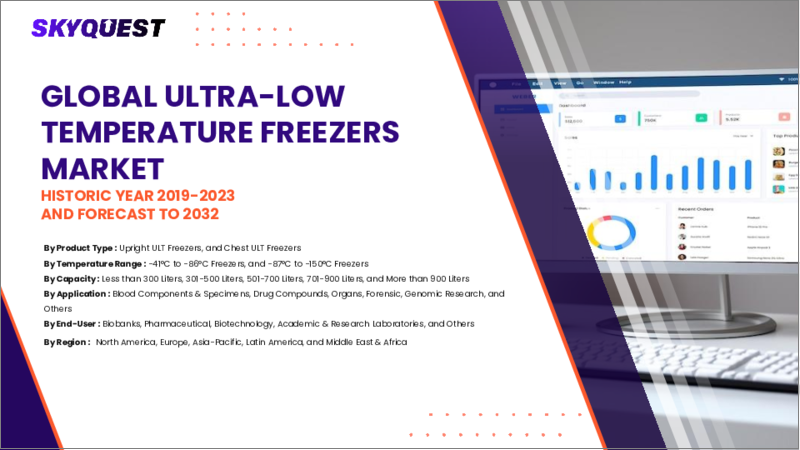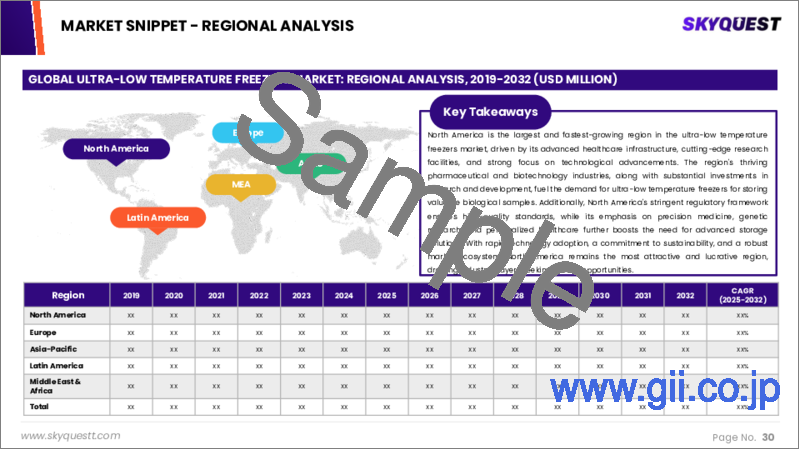|
|
市場調査レポート
商品コード
1640086
超低温フリーザーの市場規模、シェア、成長分析:タイプ別、容量別、用途別、エンドユーザー別、地域別 - 産業予測 2025~2032年Ultra-Low Temperature Freezers Market Size, Share, Growth Analysis, By Type (Chest Freezers, Upright Freezers), By Capacity (Less than 300 Liters, 301-500 Liters), By Application, By End User, By Region - Industry Forecast 2025-2032 |
||||||
|
|||||||
| 超低温フリーザーの市場規模、シェア、成長分析:タイプ別、容量別、用途別、エンドユーザー別、地域別 - 産業予測 2025~2032年 |
|
出版日: 2025年01月21日
発行: SkyQuest
ページ情報: 英文 157 Pages
納期: 3~5営業日
|
- 全表示
- 概要
- 目次
世界の超低温フリーザー市場規模は、2023年に4億7,030万米ドルと評価され、2024年の4億9,523万米ドルから2032年には7億4,857万米ドルに成長し、予測期間(2025-2032年)のCAGRは5.3%で成長する見通しです。
超低温フリーザー市場は、COVID-19パンデミックのワクチン保管・流通需要に後押しされ、大幅な成長を遂げています。FDAを含む規制機関は、ファイザー・バイオNTechのmRNA変異体のような-80℃~-60℃での保管を必要とするワクチンには、これらの冷凍庫が必要であることを強調しました。この緊急性が、パンデミック発生時の顕著な需要の急増につながった。さらに、市場の拡大は、バイオバンク、創薬、ライフサイエンス研究における多様なアプリケーションによってさらに推進されています。H3Africa UgandaのIntegrated Biorepositoryのような調査は、この分野を著しく強化し、ヘルスケアと研究イニシアチブの推進における超低温フリーザーの重要な役割を例証し、最終的に商業的実行可能性と市場での存在感を高めています。
目次
イントロダクション
- 調査の目的
- 調査範囲
- 定義
調査手法
- 情報調達
- 二次データと一次データの方法
- 市場規模予測
- 市場の前提条件と制限
エグゼクティブサマリー
- 世界市場の見通し
- 供給と需要の動向分析
- セグメント別機会分析
市場力学と見通し
- 市場概要
- 市場規模
- 市場力学
- 促進要因と機会
- 抑制要因と課題
- ポーターの分析
主な市場の考察
- 重要成功要因
- 競合の程度
- 主な投資機会
- 市場エコシステム
- 市場の魅力指数(2024年)
- PESTEL分析
- マクロ経済指標
- バリューチェーン分析
- 価格分析
- ケーススタディ
- 技術の進歩
- 規制情勢
- 特許分析
超低温フリーザー市場規模:タイプ別& CAGR(2025-2032)
- 市場概要
- チェストフリーザー
- 直立型冷凍庫
超低温フリーザー市場規模:容量別& CAGR(2025-2032)
- 市場概要
- 300リットル未満
- 301-500リットル
- 501-700リットル
- 701-900リットル
- 900リットル以上
超低温フリーザー市場規模:用途別& CAGR(2025-2032)
- 市場概要
- 血液成分と検体
- 臓器
- 医薬品
- 法医学
- ゲノム調査
- その他
超低温フリーザー市場規模:エンドユーザー別& CAGR(2025-2032)
- 市場概要
- バイオバンク
- 製薬・バイオテクノロジー企業
- 学術調査室
- その他
超低温フリーザー市場規模:地域別& CAGR(2025-2032)
- 北米
- 米国
- カナダ
- 欧州
- ドイツ
- スペイン
- フランス
- 英国
- イタリア
- その他欧州地域
- アジア太平洋地域
- 中国
- インド
- 日本
- 韓国
- その他アジア太平洋地域
- ラテンアメリカ
- ブラジル
- その他ラテンアメリカ地域
- 中東・アフリカ
- GCC諸国
- 南アフリカ
- その他中東・アフリカ
競合情報
- 上位5社の比較
- 主要企業の市場ポジショニング(2024年)
- 主な市場企業が採用した戦略
- 市場の最近の動向
- 企業の市場シェア分析(2024年)
- 主要企業の企業プロファイル
- 会社概要
- 製品ポートフォリオ分析
- セグメント別シェア分析
- 収益の前年比比較(2022-2024)
主要企業プロファイル
- Thermo Fisher Scientific Inc.(USA)
- Eppendorf AG(Germany)
- Panasonic Healthcare Co., Ltd.(Japan)
- Haier Biomedical(China)
- Helmer Scientific(USA)
- Arctiko A/S(Denmark)
- Bionics Scientific Technologies(P)Ltd.(India)
- Azbil Corporation(Japan)
- Evermed S.R.L.(Italy)
- Esco Micro Pte. Ltd.(Singapore)
- Labcold Ltd.(UK)
- Binder GmbH(Germany)
- Sheldon Manufacturing Inc.(USA)
- Stirling Ultracold(USA)
- So-Low Environmental Equipment Co., Inc.(USA)
- Zhongke Meiling Cryogenics Company Limited(China)
- Blue Star Limited(India)
- Cryo Scientific Systems Pvt. Ltd.(India)
結論と推奨事項
Global Ultra-Low Temperature Freezers Market size was valued at USD 470.3 million in 2023 and is poised to grow from USD 495.23 million in 2024 to USD 748.57 million by 2032, growing at a CAGR of 5.3% during the forecast period (2025-2032).
The ultra-low temperature freezer market has experienced substantial growth, fueled by the COVID-19 pandemic's demand for vaccine storage and distribution. Regulatory agencies, including the FDA, underscored the necessity of these freezers for vaccines, such as the Pfizer-BioNTech mRNA variant, requiring storage between -80°C and -60°C. This urgency resulted in a notable surge in demand during the pandemic's onset. Moreover, the market's expansion is further propelled by diverse applications in biobanks, drug discovery, and life sciences research. Institutions like the Integrated Biorepository of H3Africa Uganda have significantly bolstered this sector, exemplifying the essential role of ultra-low temperature freezers in advancing healthcare and research initiatives, ultimately enhancing their commercial viability and market presence.
Top-down and bottom-up approaches were used to estimate and validate the size of the Global Ultra-Low Temperature Freezers market and to estimate the size of various other dependent submarkets. The research methodology used to estimate the market size includes the following details: The key players in the market were identified through secondary research, and their market shares in the respective regions were determined through primary and secondary research. This entire procedure includes the study of the annual and financial reports of the top market players and extensive interviews for key insights from industry leaders such as CEOs, VPs, directors, and marketing executives. All percentage shares split, and breakdowns were determined using secondary sources and verified through Primary sources. All possible parameters that affect the markets covered in this research study have been accounted for, viewed in extensive detail, verified through primary research, and analyzed to get the final quantitative and qualitative data.
Global Ultra-Low Temperature Freezers Market Segmental Analysis
Global Ultra-Low Temperature Freezers Market is segmented by Type, Capacity, Application, End User and region. Based on Type, the market is segmented into Chest Freezers and Upright Freezers. Based on Capacity, the market is segmented into Less than 300 Liters, 301-500 Liters, 501-700 Liters, 701-900 Liters and More than 900 Liters. Based on Application, the market is segmented into Blood Components and Specimens, Organs, Pharmaceuticals, Forensic, Genomic Research and Other. Based on End User, the market is segmented into Bio-Banks, Pharmaceutical and Biotechnology Companies, Academic and Research Laboratories and Other. Based on region, the market is segmented into North America, Europe, Asia Pacific, Latin America and Middle East & Africa.
Driver of the Global Ultra-Low Temperature Freezers Market
The Global Ultra-Low Temperature Freezers market is significantly driven by the escalating demand for blood and its components, particularly in countries like India, where an estimated 60 million surgeries occur daily alongside 240 million primary operations and various cancer-related procedures. This high demand emphasizes the necessity for effective blood transfusions, which can arise in both urban and rural settings. The potential risks associated with improper storage and testing-exposing countless individuals to contaminated blood-underscore the importance of ultra-low temperature freezers in maintaining safe storage conditions. These freezers have transitioned from traditional cold storage solutions to being essential, lifesaving equipment that ensures compliance with stringent regulations in blood banks and laboratories.
Restraints in the Global Ultra-Low Temperature Freezers Market
The expansion of the global ultra-low temperature freezers market could face challenges in the foreseeable future, primarily attributable to a deficiency of experienced professionals adept at handling these sophisticated devices. This shortage of skilled personnel can impede optimal operation and maintenance of ultra-low temperature freezers, which are essential for preserving sensitive biological materials and pharmaceuticals. As a result, this lack of expertise may deter companies from investing in these technologies or limit their effective utilization, ultimately affecting the overall growth and adoption rate of the market during the forecast period. Addressing this skills gap will be crucial for the market's advancement.
Market Trends of the Global Ultra-Low Temperature Freezers Market
The Global Ultra-Low Temperature Freezers market is experiencing a notable trend towards the adoption of energy-efficient and sustainable solutions, driven by heightened environmental awareness and sustainability initiatives. As organizations across sectors prioritize eco-friendly practices, there is a surge in demand for ultra-low temperature freezers that reduce energy consumption and employ environmentally safe refrigerants. Manufacturers are actively engaging in research and development to deliver cutting-edge technologies that enhance efficiency while ensuring optimal performance and reliability. This trend not only reflects a commitment to sustainability but also aligns with regulatory pressures and consumer expectations, positioning the market for significant growth in environmentally-conscious applications.
Table of Contents
Introduction
- Objectives of the Study
- Scope of the Report
- Definitions
Research Methodology
- Information Procurement
- Secondary & Primary Data Methods
- Market Size Estimation
- Market Assumptions & Limitations
Executive Summary
- Global Market Outlook
- Supply & Demand Trend Analysis
- Segmental Opportunity Analysis
Market Dynamics & Outlook
- Market Overview
- Market Size
- Market Dynamics
- Drivers & Opportunities
- Restraints & Challenges
- Porters Analysis
- Competitive rivalry
- Threat of substitute
- Bargaining power of buyers
- Threat of new entrants
- Bargaining power of suppliers
Key Market Insights
- Key Success Factors
- Degree of Competition
- Top Investment Pockets
- Market Ecosystem
- Market Attractiveness Index, 2024
- PESTEL Analysis
- Macro-Economic Indicators
- Value Chain Analysis
- Pricing Analysis
- Case Studies
- Technology Advancement
- Regulatory Landscape
- Patent Analysis
Global Ultra-Low Temperature Freezers Market Size by Type & CAGR (2025-2032)
- Market Overview
- Chest Freezers
- Upright Freezers
Global Ultra-Low Temperature Freezers Market Size by Capacity & CAGR (2025-2032)
- Market Overview
- Less than 300 Liters
- 301-500 Liters
- 501-700 Liters
- 701-900 Liters
- More than 900 Liters
Global Ultra-Low Temperature Freezers Market Size by Application & CAGR (2025-2032)
- Market Overview
- Blood Components and Specimens
- Organs
- Pharmaceuticals
- Forensic
- Genomic Research
- Other
Global Ultra-Low Temperature Freezers Market Size by End User & CAGR (2025-2032)
- Market Overview
- Bio-Banks
- Pharmaceutical and Biotechnology Companies
- Academic and Research Laboratories
- Other
Global Ultra-Low Temperature Freezers Market Size & CAGR (2025-2032)
- North America (Type, Capacity, Application, End User)
- US
- Canada
- Europe (Type, Capacity, Application, End User)
- Germany
- Spain
- France
- UK
- Italy
- Rest of Europe
- Asia Pacific (Type, Capacity, Application, End User)
- China
- India
- Japan
- South Korea
- Rest of Asia-Pacific
- Latin America (Type, Capacity, Application, End User)
- Brazil
- Rest of Latin America
- Middle East & Africa (Type, Capacity, Application, End User)
- GCC Countries
- South Africa
- Rest of Middle East & Africa
Competitive Intelligence
- Top 5 Player Comparison
- Market Positioning of Key Players, 2024
- Strategies Adopted by Key Market Players
- Recent Developments in the Market
- Company Market Share Analysis, 2024
- Company Profiles of All Key Players
- Company Details
- Product Portfolio Analysis
- Company's Segmental Share Analysis
- Revenue Y-O-Y Comparison (2022-2024)
Key Company Profiles
- Thermo Fisher Scientific Inc. (USA)
- Company Overview
- Business Segment Overview
- Financial Updates
- Key Developments
- Eppendorf AG (Germany)
- Company Overview
- Business Segment Overview
- Financial Updates
- Key Developments
- Panasonic Healthcare Co., Ltd. (Japan)
- Company Overview
- Business Segment Overview
- Financial Updates
- Key Developments
- Haier Biomedical (China)
- Company Overview
- Business Segment Overview
- Financial Updates
- Key Developments
- Helmer Scientific (USA)
- Company Overview
- Business Segment Overview
- Financial Updates
- Key Developments
- Arctiko A/S (Denmark)
- Company Overview
- Business Segment Overview
- Financial Updates
- Key Developments
- Bionics Scientific Technologies (P) Ltd. (India)
- Company Overview
- Business Segment Overview
- Financial Updates
- Key Developments
- Azbil Corporation (Japan)
- Company Overview
- Business Segment Overview
- Financial Updates
- Key Developments
- Evermed S.R.L. (Italy)
- Company Overview
- Business Segment Overview
- Financial Updates
- Key Developments
- Esco Micro Pte. Ltd. (Singapore)
- Company Overview
- Business Segment Overview
- Financial Updates
- Key Developments
- Labcold Ltd. (UK)
- Company Overview
- Business Segment Overview
- Financial Updates
- Key Developments
- Binder GmbH (Germany)
- Company Overview
- Business Segment Overview
- Financial Updates
- Key Developments
- Sheldon Manufacturing Inc. (USA)
- Company Overview
- Business Segment Overview
- Financial Updates
- Key Developments
- Stirling Ultracold (USA)
- Company Overview
- Business Segment Overview
- Financial Updates
- Key Developments
- So-Low Environmental Equipment Co., Inc. (USA)
- Company Overview
- Business Segment Overview
- Financial Updates
- Key Developments
- Zhongke Meiling Cryogenics Company Limited (China)
- Company Overview
- Business Segment Overview
- Financial Updates
- Key Developments
- Blue Star Limited (India)
- Company Overview
- Business Segment Overview
- Financial Updates
- Key Developments
- Cryo Scientific Systems Pvt. Ltd. (India)
- Company Overview
- Business Segment Overview
- Financial Updates
- Key Developments






